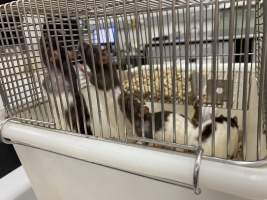- Photos
- Rats in Laboratory Housing, TAFE VIC 2022


Rats in Laboratory Housing, TAFE
Rat housing units used in laboratory setting and in TAFE/educational facilities with animal courses. Rats may be provided with a box or a polar fleece hammock as "enrichment," otherwise they are provided only food, water, litter, and a small amount of bedding material. Each cage's stocking density is determined by the weight of each rat, with cages containing as many as four or five adult rats (or a mother plus her litter) at a time, and is kept in a large rack that can contain dozens of cages.
Rats are "ear notched" for identification purposes (holes are punched in their ears in areas that correlate to a number system). This is done without any pain relief, despite less invasive alternatives such as dye marking and fur trimming being well known and similarly effective.
These rats will be used for breeding, and to train veterinary students to give injections, pap smears, and other procedures. When no longer useful, they will be killed using a Co2 gas chamber (proven to cause distress and pain in rats). Rats in this TAFE facility are noted as being very afraid of people and difficult to handle, and showing signs of stress in the form of barbering* and excessive porphyrin** staining. This particular TAFE is known for it's "high welfare standards," and the caging is laboratory-consistent to prepare students for possible entry into the animal technology industry (AKA animal experimentation).
This cage contained four female rats of the Long-Evans strain. For rats to be a part of a strain, they must be inbred for at least 20 generations. The Long-Evans is one of the most popular strains in laboratories worldwide.
*When an animal chews or pulls the hair from themselves or a cagemate, causing bald spots or shorn hairs. Typically a sign of boredom and stress. Some strains of rats are more prone to barbering, but it is always atypical outside of extreme confinement.
**Rats have a compound in their mucus, called porphyrin, which makes their tears and mucus from their nostrils red in colour. When rats are stressed, they produce more mucus, and groom it off less. This causes staining on the face, front legs, and along the sides of the rat, as well as staining of their environment. In healthy, content rats, porphyrin is rarely seen and only in small amounts.
Rats are "ear notched" for identification purposes (holes are punched in their ears in areas that correlate to a number system). This is done without any pain relief, despite less invasive alternatives such as dye marking and fur trimming being well known and similarly effective.
These rats will be used for breeding, and to train veterinary students to give injections, pap smears, and other procedures. When no longer useful, they will be killed using a Co2 gas chamber (proven to cause distress and pain in rats). Rats in this TAFE facility are noted as being very afraid of people and difficult to handle, and showing signs of stress in the form of barbering* and excessive porphyrin** staining. This particular TAFE is known for it's "high welfare standards," and the caging is laboratory-consistent to prepare students for possible entry into the animal technology industry (AKA animal experimentation).
This cage contained four female rats of the Long-Evans strain. For rats to be a part of a strain, they must be inbred for at least 20 generations. The Long-Evans is one of the most popular strains in laboratories worldwide.
*When an animal chews or pulls the hair from themselves or a cagemate, causing bald spots or shorn hairs. Typically a sign of boredom and stress. Some strains of rats are more prone to barbering, but it is always atypical outside of extreme confinement.
**Rats have a compound in their mucus, called porphyrin, which makes their tears and mucus from their nostrils red in colour. When rats are stressed, they produce more mucus, and groom it off less. This causes staining on the face, front legs, and along the sides of the rat, as well as staining of their environment. In healthy, content rats, porphyrin is rarely seen and only in small amounts.
| Categories | |
| Species | |
| Published | Mon 31 October 2022 |
| Captured/filmed | October 2022 |
| ID | r26f8psvpqxe89yrysd0 |
| Credits & licensing |
This work is licensed under a Creative Commons Attribution 4.0 International License.
Please credit: Windchime. Link not required. |
| Country | Australia |
| Location | VIC |


